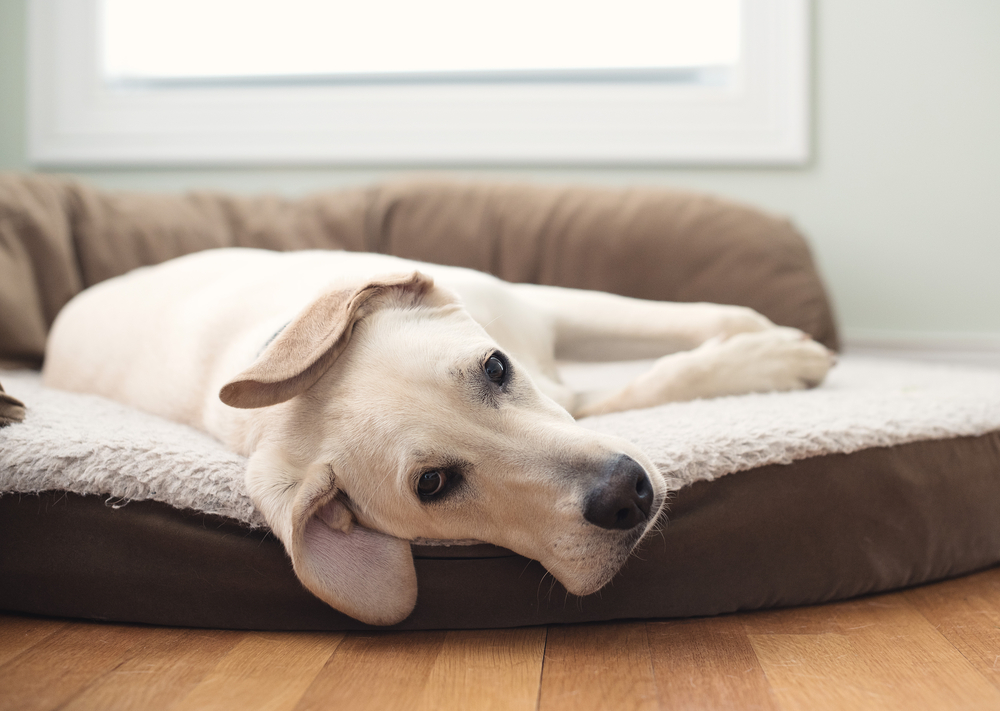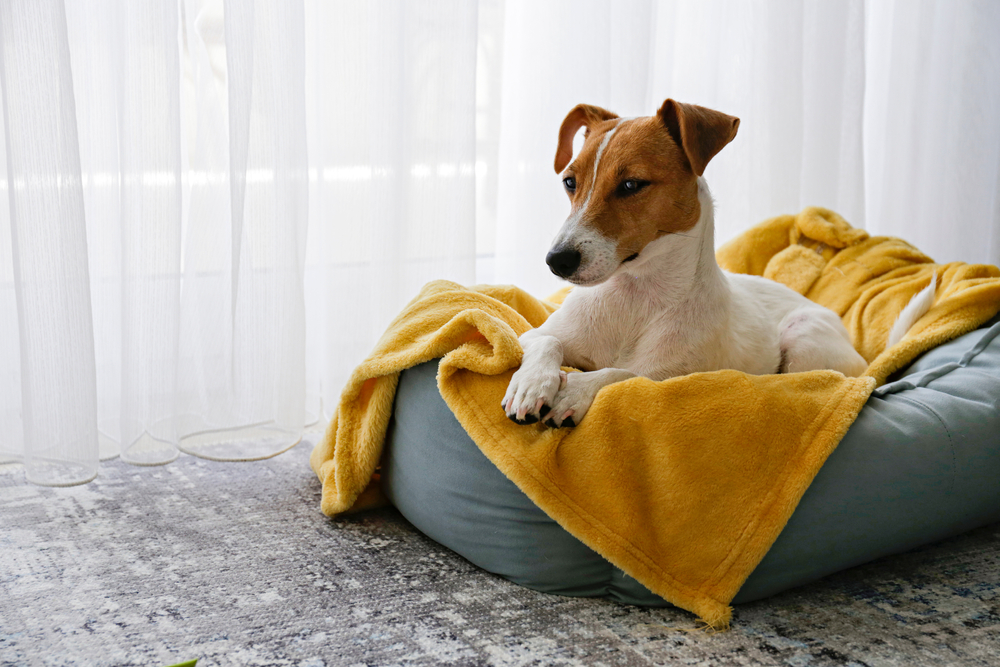Calming Dog Beds

Owning a dog is a rewarding experience, and your canine friend quickly becomes a loving member of your family.
Like us, dogs have their own unique personality, and just like humans, dogs can suffer from anxiety. Unlike humans, though, dogs can’t verbally communicate when something is wrong, so as dog owners, we need to be able to read the signs of issues such as anxiety and help our dogs to cope.
Dogs can experience various types of anxiety, and there is a range of common symptoms in anxious dogs, as well as treatments available. We take a look at some here
Fear of loud noises
While some dogs remain cool as a cucumber, others show signs of anxiety when faced with loud noises such as fireworks or thunderstorms.
Dogs who are fearful of these loud noises may associate what accompanies those noises and become anxious. An example of this would be sensing heavy rain, a strong wind, or a storm brewing, resulting in a thunderstorm.
Separation anxiety
Just like children, your dog may not like being apart from you and may suffer from separation anxiety. This is the most common form of anxiety in dogs and is often because they associate enjoyment such as food, company, playing, and walks with people. Dogs who suffer from separation anxiety may realise that none of these activities occur when they are left alone.
To prevent separation anxiety, your dog needs to learn to cope without you. The best time to instil this is when they are young.
Resource guarding
Although not as common, some dogs may become anxious and show aggressive behaviour towards people or other dogs if they are anxious about something they value, such as a toy or bone, being taken away.
Change of environment
Also less common, some dogs may become anxious when something in their environment changes, such as moving house or going to the vet.
So, how do you know if your dog is anxious? Here are some key signs:
• Not eating/lack of interest in food
• Pacing and panting
• Digging
• Howling/barking when left home alone
• Shivering
• Escaping from the yard
• Cowering
• Looking away
• Frequent urinating
• Not settling
• Destroying furniture
• Excessive chewing or licking

Relieving anxiety in your dog can be an ongoing process, and a number of tools and treatments can be helpful. Anti-anxiety dog beds/calming dog beds can be a great source of comfort for your dog and assist in treating their anxiety.
Sleep and rest are an important part of a dog’s life, and depending on their age, dogs sleep anywhere from 12 to 18 hours a day. These calming dog beds are designed to help ease stress and anxiousness in dogs by giving dogs a sense of security. Anxiety dog beds work best when used alongside training and possibly even medication.
Like us, dogs appreciate comfort and love to sleep, and particularly if your dog is prone to anxiety, it’s important to find an appropriate comforting dog bed.
At times your dog might snuggle with you, but dogs also need a bed of their own. This also gives them their own dedicated place to relax and chill out when you’re not around.
Choosing the best calming dog bed can be overwhelming. Anti-anxiety dog beds come in a range of materials, shapes, styles, and sizes. Of course, price is also a factor. When looking for anxiety dog beds, a vast range is available to suit your taste and budget – and of course, your dog!
Calming dog beds can also be helpful for new puppies and dogs with joint pain, giving a sense of security and comfort. Features and types of anti-anxiety dog beds include:
• Self-heating - self-warming dog beds offer a warm, calming environment to assist in calming dogs. Some dogs also become stressed when they’re cold.
• Orthopaedic padding – relieves pressure on muscles and joints and provides extra comfort, in turn helping to ease anxiety. As pain can cause anxiety, a calming dog bed can help your dog relax.
• Bolstered edges/Raised edges - Raised edges can support your dog’s body to help minimise joint and muscle pain and offer comfort, in turn helping to reduce anxiety.
These beds give dogs a soft surface to lean and rest their heads and are particularly great for large dogs and dogs who feel calmer when they can curl up or have something soft and supportive to lean against.
• Doughnut style – small dogs in particular find comfort in doughnut style beds that provide a comforting headrest and allow them to curl up.
• Cave style/Burrowing hiding places – these calming dog beds can give your dog a sense of security and an area to burrow into, calming the anxious dog’s sensory behaviours. These comforting beds are suitable for both small and larger dogs and often have an interior made of soft, cuddly fabric.
Some factors to keep in mind when looking for the best calming dog bed to suit your canine friend include:
• Easy to clean - such as a removable, washable cover. Regularly washing your calming dog bed will also minimise germs and dog hair, as well as doggy aromas!
• Odour resistant – look for a material that is less prone to retaining odour, such as anti-bacterial faux fur.
• Waterproof lining – making your dog’s bed easy to clean in case of any accidents, and ensuring a dry, comfortable bed.
• Appropriate size – look for an anti-anxiety dog bed that is big enough for your dog to stretch out and circle around in, but still has a comforting, ‘cocooning’ effect.
• Non-slip – if the bottom of the bed is slippery, it may increase your dog’s anxiety levels.
Anti-anxiety, calming dog beds can be particularly helpful if your dog’s anxiety stems from being left alone (separation anxiety) or from loud noises – the most common forms of anxiety. However, a calming dog bed alone may not be the sole solution, and you may also need to consider training, other calming tools, or medication. Patting your dog gently on his body and face, massaging his ears, and stroking his chest may also help your dog feel relaxed and comfortable in his new calming dog bed.
Popular Questions Asked
Which calming dog bed is the best?
There are so many calming dog beds it can be overwhelming to choose. They come in so many different materials, shapes, sizes, and styles such as self-heating, orthopaedic padding, raised edges, doughnut style dog beds, odour resistant and more.
Why do calming dog beds work?
Calming dog beds are a great source of comfort for your dog and assist in treating their anxiety. Sleep and rest are very important to a dog, and calming dog beds are designed to help ease any stress and anxiousness a dog has by giving them a sense of security.
What can i look for in a calming dog bed?
Most dogs love something to snuggle into. The support of sides of the bed gives dogs a sense of security, and warmth, making them feel comfortable, safe, and free of any anxiety. The raised lip of the dog bed contributes to the calming quality of a dog bed.
What is the best calming dog bed in Australia?
The best calming dog beds in Australia are probably orthopaedic dog beds. Not only do they give your dog a sense of security, but they relieve pressure on muscles and joints, providing extra comfort, helping your dog relax.